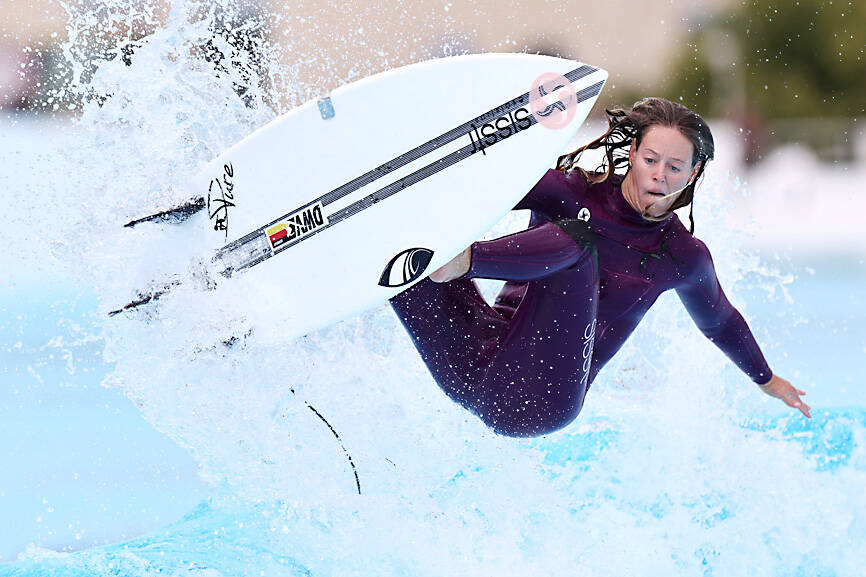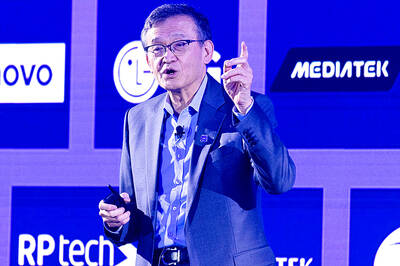Pickup trucks and sport utility vehicles pull into a parking lot, surfboards stashed in the back. Not an unusual sight in Southern California on a hot blue-sky morning in May, except this is the Coachella Valley, about 160km inland from the nearest beach.
The would-be surfers trek over to an expanse of desert dirt surrounded by a verdant golf course and framed by the snow-capped San Jacinto Mountains. Their surfboards are just props for a groundbreaking ceremony, but the spot is set to be submerged under nearly 26.5 million liters of water.
The 2 hectare lagoon would generate artificial, but ocean-like waves shaped by software.

Photo: EPA-EFE
The US$236 million project, called DSRT Surf, would also include a hotel, restaurants and private villas. It is among dozens of similar surf parks either currently operating or under development around the world.
Thanks to advances in computational fluid dynamics — the science of how water flows — and the rapidly declining cost of computing power, surfer-entrepreneurs have cracked the code on how to replicate the complex physics of breaking ocean waves.
DSRT Surf is one of four surf parks that had been planned in the past few years for this water-stressed stretch of the Sonoran Desert southeast of Los Angeles.
Landlocked aspiring surfers can already pay upward of US$125 an hour to ride waves in the Swiss Alps, on former farmland in the UK, and next year, in Virginia Beach, Virginia, just blocks from an actual surf break. Some wealthy surfers are even building eight-figure wave pools on their estates.
“You might ask: ‘All this great surf and this giant lagoon, is that irresponsible?’” Doug Sheres, a founding partner at Beach Street, DSRT Surf’s developer, said at the May groundbreaking in Palm Desert. “‘You’re putting all this water out there in the middle of the desert. Who would do something like that?’”
“And the answer is, well, it’s really not as irresponsible as you might think,” he said.
Surf park proponents point out that the DSRT Surf lagoon is expected to use about 8 percent of the water of a typical 18-hole golf course in the Coachella Valley. The resort would offset the wave pool’s annual 90 million liter consumption of drinking water by replacing some of the surrounding golf course turf with drought-resistant landscaping.
Still, generating tens of millions of freshwater waves around the world requires enormous amounts of water, electricity and carbon-intensive concrete, and as surf parks proliferate, so has scrutiny of their climate footprint.
Minimizing energy and water impacts is not only an economic necessity to make projects profitable, but a cultural one as wave pool operators seek to attract customers to a sport defined by its environmental ethos, even as they transform the joyful randomness of riding waves in the ocean into a more regimented and transactional experience.
“It’s the first time in history we can take the beach and plant it anywhere and push a button and there’s waves,” Aaron Trevis, founder of wave tech company Surf Lakes, said at the October Surf Park Summit, an industry conference held overlooking a surf beach in San Diego. “Waves will become a commodity.”
It is not a commodification of nature everyone has welcomed. A judge in May issued an injunction against a proposed US$106 million Oahu surf park after a Native Hawaiian group sued, alleging it would deplete drought-stressed local water supplies and damage the coastal environment.
Some surfers question their purpose, too.
“In my mind, they’ll always be a poor facsimile of the ocean, a diminished Blade Runner-eque future,” said Chad Nelsen, chief executive of the climate and coastal advocacy group Surfrider Foundation.

The Eurovision Song Contest has seen a surge in punter interest at the bookmakers, becoming a major betting event, experts said ahead of last night’s giant glamfest in Basel. “Eurovision has quietly become one of the biggest betting events of the year,” said Tomi Huttunen, senior manager of the Online Computer Finland (OCS) betting and casino platform. Betting sites have long been used to gauge which way voters might be leaning ahead of the world’s biggest televised live music event. However, bookmakers highlight a huge increase in engagement in recent years — and this year in particular. “We’ve already passed 2023’s total activity and

Nvidia Corp CEO Jensen Huang (黃仁勳) today announced that his company has selected "Beitou Shilin" in Taipei for its new Taiwan office, called Nvidia Constellation, putting an end to months of speculation. Industry sources have said that the tech giant has been eyeing the Beitou Shilin Science Park as the site of its new overseas headquarters, and speculated that the new headquarters would be built on two plots of land designated as "T17" and "T18," which span 3.89 hectares in the park. "I think it's time for us to reveal one of the largest products we've ever built," Huang said near the

China yesterday announced anti-dumping duties as high as 74.9 percent on imports of polyoxymethylene (POM) copolymers, a type of engineering plastic, from Taiwan, the US, the EU and Japan. The Chinese Ministry of Commerce’s findings conclude a probe launched in May last year, shortly after the US sharply increased tariffs on Chinese electric vehicles, computer chips and other imports. POM copolymers can partially replace metals such as copper and zinc, and have various applications, including in auto parts, electronics and medical equipment, the Chinese ministry has said. In January, it said initial investigations had determined that dumping was taking place, and implemented preliminary

Intel Corp yesterday reinforced its determination to strengthen its partnerships with Taiwan’s ecosystem partners including original-electronic-manufacturing (OEM) companies such as Hon Hai Precision Industry Co (鴻海精密) and chipmaker United Microelectronics Corp (UMC, 聯電). “Tonight marks a new beginning. We renew our new partnership with Taiwan ecosystem,” Intel new chief executive officer Tan Lip-bu (陳立武) said at a dinner with representatives from the company’s local partners, celebrating the 40th anniversary of the US chip giant’s presence in Taiwan. Tan took the reins at Intel six weeks ago aiming to reform the chipmaker and revive its past glory. This is the first time Tan